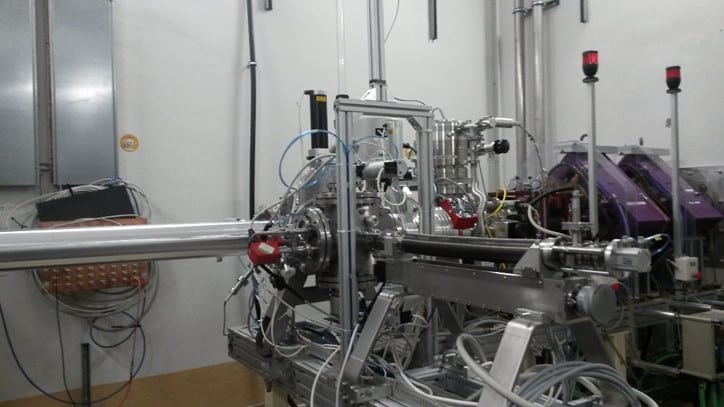- Homepage
- >
- Scientists
- >
- News & Highlights
- >
- 2025
- >
- Measurements at SPIRAL2 for Nuclear Medicine
Measurements at SPIRAL2 for Nuclear Medicine
At GANIL (Grand Accélérateur National d’Ions Lourds/CEA-CNRS), a one-of-a-kind particle accelerator has contributed to the development of targeted alpha therapy. Thanks to SPIRAL2, researchers were able to obtain precise data on the production of astatine-211, a promising isotope for cancer treatment, as well as on astatine-210, its dangerous and previously little-known neighbor.

A discreet but promising isotope
Among the dozens of radioisotopes studied for medicine, astatine-211 holds a special place. It must be artificially produced, but it has very attractive properties for targeted alpha radiotherapy.
Its main advantage: during its decay, it emits an alpha particle, which is extremely energetic but travels only a very short distance in the body (a few tens of micrometers). By preferentially binding to tumor cells or their nearby environment via a specific ligand, the radioactive isotope concentrates near micro-tumors. The emitted alpha particles then cause irreversible damage to the DNA of cancer cells while limiting harm to healthy tissue due to their short range.
Additionally, it has a half-life of 7.2 hours, long enough for astatine-211 to be produced, transported, and used in hospitals. Its chemistry, similar to that of iodine, also facilitates the development of vector molecules suitable for imaging. These qualities make astatine-211 a prime candidate for inclusion in nuclear medicine arsenal.
The problem of astatine-210: a shadow on the picture
Problem: astatine-211 does not exist naturally. It can be produced artificially by bombarding bismuth with alpha particles. However, this also generates an undesirable isotope, astatine-210, whose radioactive decay leads to polonium-210, infamous for its extreme toxicity. Avoiding this contamination is essential for safe medical use.
Chemically eliminating astatine-210 is impossible, as it has exactly the same chemical properties as astatine-211. The only solution is to finely control the particle beam energy to maximize astatine-211 production while minimizing astatine-210. Unfortunately, experimental data on astatine-210 are scarce, fragmented, and carry significant uncertainties. Consequently, international databases lack reliable references and precision on astatine-210 production.
As long as this bottleneck persists, it limits the medical development of astatine-211.
The advantages of SPIRAL2
This is where SPIRAL2, GANIL’s superconducting linear accelerator, comes in. Designed to provide intense, precisely controlled ion beams, it represents a technological breakthrough compared to cyclotrons, which are mostly used for these studies.
SPIRAL2 achieves energy precision better than 0.1% and offers easily adjustable energy. Moreover, the accelerator’s flexible tuning allows the use of a single target by precisely varying the energy, whereas previous experiments required stacking targets (“stacked foils”), introducing additional energy dispersion and less controlled astatine-210 production.
Finally, the use of the EXOGAM detector, a high-efficiency gamma spectrometer, allows precise measurement of the characteristic radiation of the produced isotopes, even when activities in the target are very low.
Measurements addressing a scientific bottleneck
Thanks to this combination of tools, researchers studied the production of astatine-210 and astatine-211 in the critical energy range of 28 to 31 MeV. They reliably observed the gradual rise of astatine-210 production from 28.6 MeV and the peak production of astatine-211 around 31 MeV. The data partly confirm previous results on astatine-211, but most importantly provide a new, robust dataset for astatine-210, where the literature had remained unclear. This allows correction and refinement of nuclear databases.
Towards a new generation of therapeutic radioisotopes
The stakes go beyond the academic sphere. In nuclear medicine, the lack of reliable experimental data on astatine-210 has been a barrier to the clinical development of astatine-211. With these new data, production conditions can be optimized to ensure an At-211/At-210 ratio compatible with medical use.
This experiment demonstrates that the SPIRAL2 facility, originally built to address fundamental nuclear physics questions, can become a key tool for studying and producing therapeutic radioisotopes, combining intensity, stability, and energy precision. Astatine-211 may be just the first in a series of radionuclides produced and characterized under ideal conditions.
Contact: Anne-Marie FRELIN
https://doi.org/10.1016/j.apradiso.2025.112061
S. Ansari, A.M. Frelin et al : Optimizing 211At production cross section by studying the rise of 210At cross section: First measurement using Linac SPIRAL2
